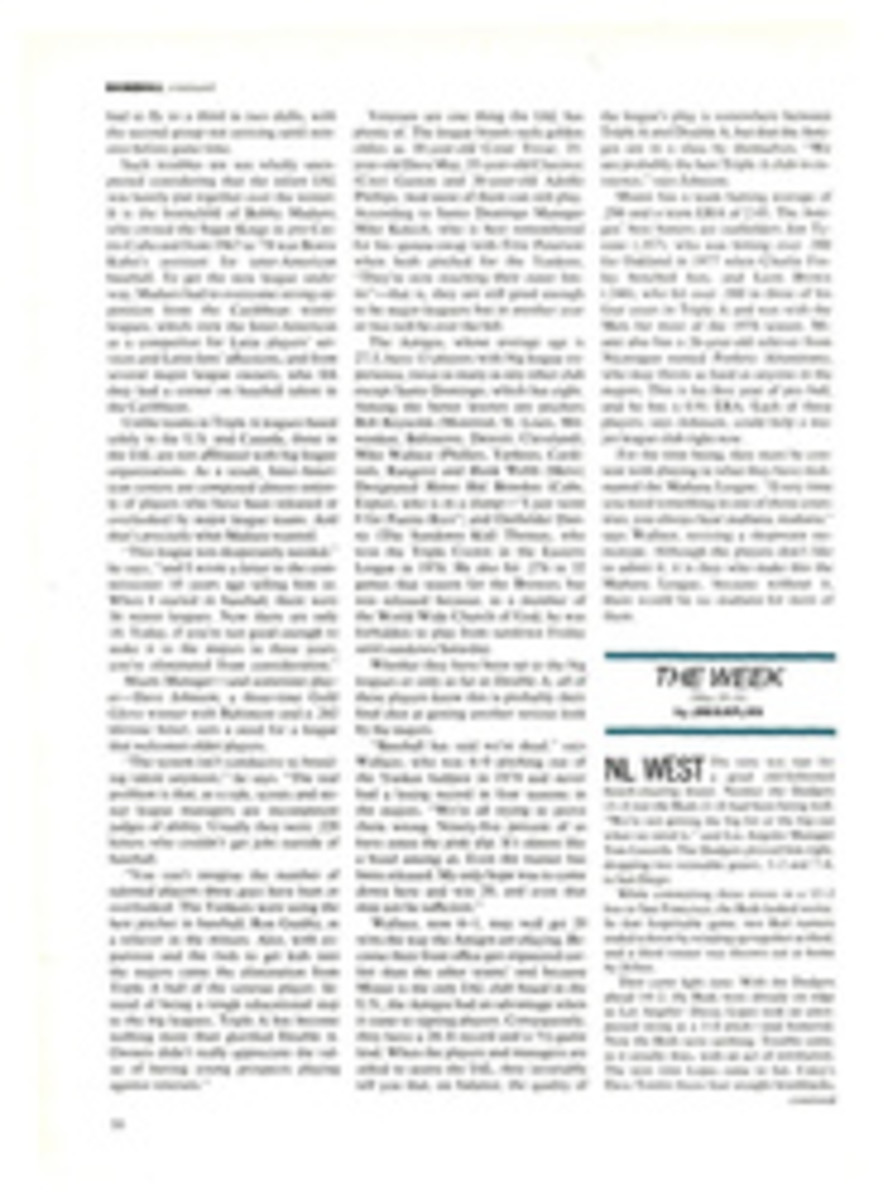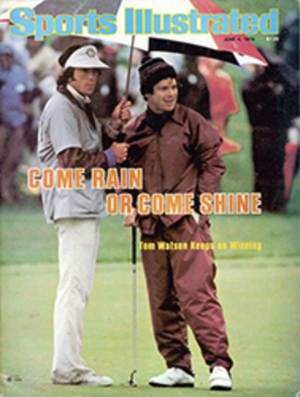
The over-the-hill league
With their tongues planted firmly in their cheeks, the players were touting the game as the Cuban Death Match. Facing each other were 42-year-old Mike Cuellar and 34-year-old Oscar Zamora. Cuellar, the masterful screwballer, was a three-time 20-game winner for the Orioles a while back and in 1969 shared the American League Cy Young Award. The less-renowned Zamora played for the Astros as recently as last season. He now has a thriving shoe business in Miami and finds time to pitch only every eighth day or so.
This Latin showdown didn't occur in an oldtimers' game in Baltimore or on a dusty diamond in San Juan, but in Miami, where the Amigos were opening their second home stand of the year against the San Juan Boricuas. And who in the world are the Amigos and the Boricuas? Well, they are none other than the first- and fourth-place teams, respectively, in the fledgling Inter-American League. The Inter-American is different from other minor leagues, not only because it is peopled largely by players with familiar and semifamiliar names, but also because it has clubs in Panama City, Panama; Santo Domingo, Dominican Republic; and Caracas and Maracaibo, Venezuela, as well as in Miami and San Juan.
On this night a predominantly Latin crowd of 3,152—the Amigos' largest turnout of the season—came to see the new show in town, and they weren't disappointed. After giving up two runs in the first inning, Zamora settled down and beat San Juan on six hits, two of them by Bobby Tolan, late of the Cards, Reds, Padres, Phils, Pirates and Nankai Hawks. Inspired by their cheerleaders, the Hot and Juicy Wendy's Girls, the Amigos shelled Cuellar in the fifth when First Baseman Brock Pemberton, who played for the Mets in '75, hit a grand-slam home run. The loss was the first in five decisions for Cuellar, who has been pitching with a pulled hamstring since his third start.
Many of the Cuban expatriates in the crowd had seen Cuellar pitch for the Havana Sugar Kings in 1957 and '58, and the game had the same festive atmosphere that characterizes games in Cuba. The spectators beat out Latin rhythms on conga drums and cowbells and reacted vociferously to events both on and off the field. When a shapely young woman in hot pants and halter top left her seat, she got a rousing round of applause. Her return was greeted by a standing ovation that stopped the game.
Unfortunately, customs and immigration officials aren't as thrilled by the goings-on in the Inter-American League. When the Boricuas left Caracas for Miami, the authorities kept Cuellar from boarding the team's flight, and he barely made it to the game on time. Nobody knows exactly what the holdup was, except that it concerned visas, which are a persistent problem for the Cuban-born players in the league. Miami backup Catcher Jorge Curbelo hasn't made it into Venezuela in two tries. In addition, a few members of the Santo Domingo Azucareros failed to show for a game in Puerto Rico, reportedly because of visa difficulties. Visas aren't the Azucareros' only problems; the club's discombobulated management didn't send box scores to the league until the season was six weeks old.
Immigration and front-office foul-ups are just a few of the IAL's many growing pains. After only six weeks of the season, two owners, two general managers and one manager have been replaced, and the Boricuas have moved some of their games from San Juan to various sites in the interior of the Commonwealth because they were drawing only about 200 fans a game. In fact, attendance has been poor everywhere except Caracas, where the Metropolitanos are attracting nearly 7,400 a game, 2,400 more than any other Triple A team and 3,500 more than the Oakland A's.
Traveling has also been rough, even by minor league standards. In most places, the hotels and clubhouses have been decidedly second-rate, and the Amigos have yet to take a flight that wasn't at least an hour late. Because of the vagaries of Caribbean air travel, they have started one game at 10 p.m., had another suspended in the eighth inning and had to fly to a third in two shifts, with the second group not arriving until minutes before game time.
Such troubles are not wholly unexpected considering that the infant IAL was hastily put together over the winter. It is the brainchild of Bobby Maduro, who owned the Sugar Kings in pre-Castro Cuba and from 1967 to '78 was Bowie Kuhn's assistant for inter-American baseball. To get the new league under way, Maduro had to overcome strong opposition from the Caribbean winter leagues, which view the Inter-American as a competitor for Latin players' services and Latin fans' affections, and from several major league owners, who felt they had a corner on baseball talent in the Caribbean.
Unlike teams in Triple A leagues based solely in the U.S. and Canada, those in the IAL are not affiliated with big league organizations. As a result, Inter-American rosters are composed almost entirely of players who have been released or overlooked by major league teams. And that's precisely what Maduro wanted.
"This league was desperately needed," he says, "and I wrote a letter to the commissioner 10 years ago telling him so. When I started in baseball, there were 56 minor leagues. Now there are only 18. Today, if you're not good enough to make it to the majors in three years, you're eliminated from consideration."
Miami Manager—and sometime player—Dave Johnson, a three-time Gold Glove winner with Baltimore and a .262 lifetime hitter, sees a need for a league that welcomes older players.
"The system isn't conducive to breeding talent anymore," he says. "The real problem is that, as a rule, scouts and minor league managers are incompetent judges of ability. Usually they were .220 hitters who couldn't get jobs outside of baseball.
"You can't imagine the number of talented players these guys have hurt or overlooked. The Yankees were using the best pitcher in baseball, Ron Guidry, as a reliever in the minors. Also, with expansion and the rush to get kids into the majors came the elimination from Triple A ball of the veteran player. Instead of being a tough educational step to the big leagues, Triple A has become nothing more than glorified Double A. Owners didn't really appreciate the value of having young prospects playing against veterans."
Veterans are one thing the IAL has plenty of. The league boasts such golden oldies as 38-year-old Cesar Tovar, 35-year-old Dave May, 35-year-old Clarence (Cito) Gaston and 36-year-old Adolfo Phillips. And most of them can still play. According to Santo Domingo Manager Mike Kekich, who is best remembered for his spouse-swap with Fritz Peterson when both pitched for the Yankees, "They're now reaching their outer limits"—that is, they are still good enough to be major-leaguers but in another year or two will be over the hill.
The Amigos, whose average age is 27.5, have 13 players with big league experience, twice as many as any other club except Santo Domingo, which has eight. Among the better known are pitchers Bob Reynolds (Montreal, St. Louis, Milwaukee, Baltimore, Detroit, Cleveland), Mike Wallace (Phillies, Yankees, Cardinals, Rangers) and Hank Webb (Mets); Designated Hitter Hal Breeden (Cubs, Expos), who is in a slump—"I just went 0 for Puerto Rico"; and Outfielder Danny (The Sundown Kid) Thomas, who won the Triple Crown in the Eastern League in 1976. He also hit .276 in 32 games that season for the Brewers but was released because, as a member of the World Wide Church of God, he was forbidden to play from sundown Friday until sundown Saturday.
Whether they have been up to the big leagues or only as far as Double A, all of these players know this is probably their final shot at getting another serious look by the majors.
"Baseball has said we're dead," says Wallace, who was 6-0 pitching out of the Yankee bullpen in 1974 and never had a losing record in four seasons in the majors. "We're all trying to prove them wrong. Ninety-five percent of us have eaten the pink slip. It's almost like a bond among us. Even the trainer has been released. My only hope was to come down here and win 20, and even that may not be sufficient."
Wallace, now 6-1, may well get 20 wins the way the Amigos are playing. Because their front office got organized earlier than the other teams' and because Miami is the only IAL club based in the U.S., the Amigos had an advantage when it came to signing players. Consequently, they have a 28-8 record and a 7½-game lead. When the players and managers are asked to assess the IAL, they invariably tell you that, on balance, the quality of the league's play is somewhere between Triple A and Double A, but that the Amigos are in a class by themselves. "We are probably the best Triple A club in existence," says Johnson.
Miami has a team batting average of .296 and a team ERA of 2.45. The Amigos' best batters are outfielders Jim Tyrone (.357), who was hitting over .300 for Oakland in 1977 when Charlie Finley benched him, and Leon Brown (.346), who hit over .300 in three of his four years in Triple A and was with the Mets for most of the 1976 season. Miami also has a 26-year-old reliever from Nicaragua named Porfirio Altamirano, who may throw as hard as anyone in the majors. This is his first year of pro ball, and he has a 0.91 ERA. Each of these players, says Johnson, could help a major league club right now.
For the time being, they must be content with playing in what they have nicknamed the Mañana League. "Every time you need something in one of those countries, you always hear mañana, mañana," says Wallace, reviving a shopworn stereotype. Although the players don't like to admit it, it is they who make this the Mañana League, because without it, there would be no mañana for most of them.
PHOTO
Manager Johnson no longer bats often, but his Amigos have been a big hit with a 28-8 record.

